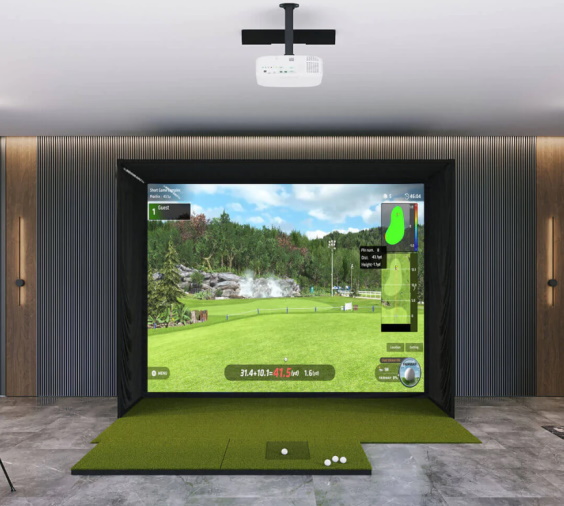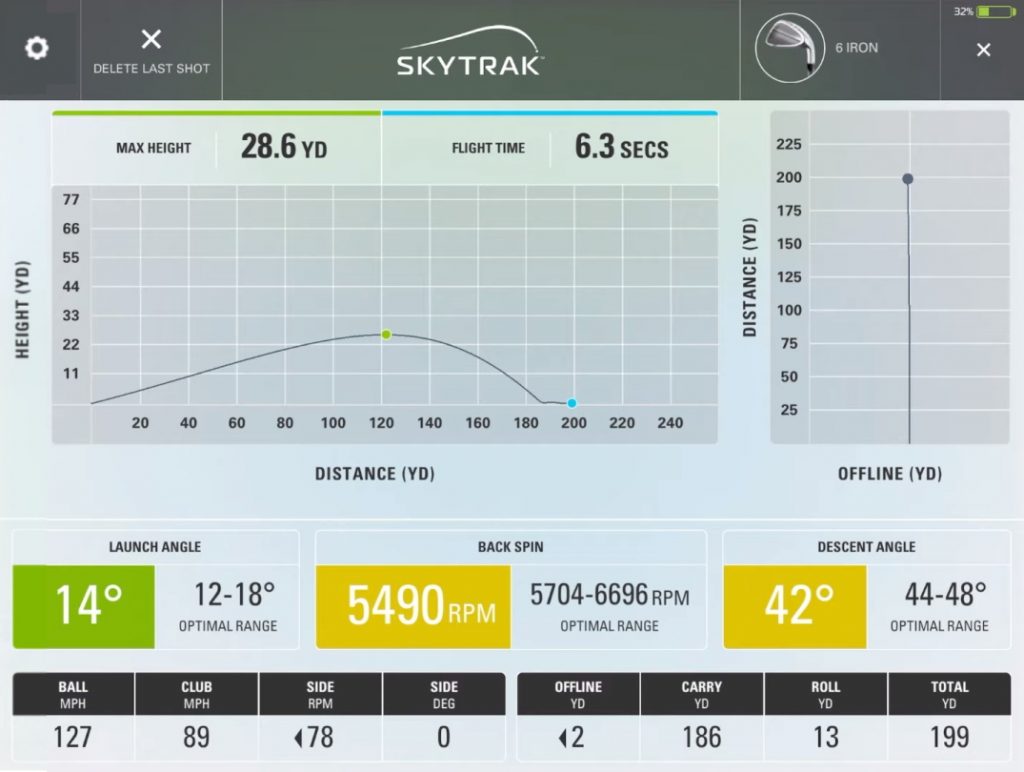Golfstead is reader-supported. When you buy through links on the site, we may earn an affiliate commission at no extra cost to you. Our affiliations include, but are not limited to, the eBay Partner Network and Amazon Associates.
Quick Answer: a golf simulator is essentially a computer which takes details of a shot and swing, processes and analyzes the data, sends the data to simulator software, and provides the analyzed results as output.
Since the emergence of the first golf simulators in the 1970s, golf simulators have improved tremendously both in terms of technology and accuracy.
A golf simulator is a high-tech system that enables you to practice golf indoors in a virtually simulated golf environment. It is a computerized golf setup designed to mimic the real game, helping you analyze your swing, understand your weaknesses, and improve your game without having to go to your local course.
Day by day, golf simulators are becoming more popular among golf enthusiasts, and this trend accelerated during the recent pandemic.
Purpose Of Golf Simulators
Golf simulators help you play golf anytime and anywhere in converted, controlled premises without any restrictions on time, place or weather.
Golf simulators have become one of the favourite pastimes for golfers. Any golfer, be it an amateur or a professional, can use a golf simulator to practice, record and analyze his/her performance through the entire bag from driver to putter.
One of the best things about golf simulators is that they give you the opportunity to play many world-famous golf courses that you might not have the opportunity or means to play in real life, such as Augusta National.
These software simulations also contain grass, trees and other foliage, and imitate the feel of being out on a real course. Accurate renditions of the courses on the screen make it feel more real.
Today, many golf simulator software solutions like QED Ignite and The Golf Club 2019 have ultra-realistic graphics. In our view, it’s only a matter of time before we see augmented-reality golf simulator systems.
Composition Of Golf Simulators
Golf simulators consist of a combination of hardware and software.
The hardware includes things like cameras, radars, optical sensors, hitting mats, projectors and screens, enclosures, nets, and sound systems.
The software takes the measured parameters such as ball speed, club speed, clubface angle, club path, spin, vertical and horizontal launch angle, etc., and simulates the shot in a virtual environment. Alternatively, some small software apps may only display numerical values and produce charts to help you analyze your results.
Different Types Of Golf Simulators
Golf simulators will use various technologies to track ball and club data. These types include:
Photometric

Photometric simulators are camera-based systems that are quite flexible, and can be used indoors as well as outdoors.
These simulators capture high-speed images of the ball immediately after impact and, based on these images, derive various data parameters. This data leads to the rendering of shot shape and distance.
Photometric systems can also capture other data such as launch angle, distance away from center, backspin, and side spin. Arguably the most well-known photometric golf simulator is the SkyTrak.
Similar to a photometric system is a stereoscopic system, an example of which is the Foresight Sports GC2. This takes high-speed images of the ball from two different angles; viewed together, it increases the accuracy of the measurements.
You can go even further to triscopic and quadrascopic systems, which use three and four cameras respectively to produce extremely accurate measurements. Examples of these are the GC3 and GCQuad, respectively.
Infrared

Infrared simulators emit light signals in order to capture the precise position of the clubhead.
Since the ball itself is not measured, you can easily use foam or plastic balls with infrared simulators. However, it’s for this reason that they tend to not be as effective and reliable as other systems.
The OptiShot 2 is probably the most well-known infrared simulator system on the market. Foresight Sports GC systems use some infrared object tracking as well.
Radar

Radar-based simulators track the ball with the help of Doppler radar technology. These radars emit a microwave signal from the unit which bounces back from the golf ball after impact.
Since it requires seeing the ball travel post-impact, radar is ideal for outdoors use, although it can also be used indoors as long as there is sufficient free ball flight.
At the same time, because it uses microwave signals, it is not affected by ambient lighting conditions unlike with photometric and infrared systems.
The main disadvantage of radar simulators is that the units need to sit many feet behind the clubhead; this typically makes them unable to measure certain parameters such as ball impact location or club face orientation.
Some of the most prominent radar-based golf simulators are the FlightScope Mevo, Garmin Approach R10, FlightScope X3, and TrackMan.
How Do Golf Simulators Work?
The operating process of a simulator is similar to that of a computer and involves taking details of the shot and swing, which is followed by processing and analyzing the data and finally providing the analyzed results as output.
In essence, there is not much difference between playing golf in a simulator and on a real golf course. In a golf simulator, there’s an area in front of the net or screen called the swing pad on which you stand to play.
Then there are the sensors, cameras or radars that function by taking the data of the swing and shot and sending it to the software for processing, after which the result is shown. In order to run golf simulator software, you need a tablet, smartphone, or PC.

The golf courses and practice ranges can be projected on a life-size screen, with all the necessary information about the hole, distances, etc. displayed as well.
Process
Golf simulators function through a process of simulation — it’s basically a depiction of one set of characteristics in some visual form.
1. Taking Input
There are many possible input devices such as radars, light sensors, or other motion-detecting hardware around the edges of the hitting bay.
You must hit your shot naturally, standing by the hitting mat and facing the net or screen.
2. Processing Of Data And Analysis
As soon as the golf ball takes off from the impact zone, the simulation software, with the help of the tracking system, process the details of the shot and analyze its various factors including ball speed, club head speed, face angle, and many other parameters.
3. Delivering Output
Once the data is received by the tracking system, the software determines where the ball should land, and this data is then projected in numeric form along with the visual on the screen.
Golf Simulator Putting Technology
If you’re going to spend a lot of time playing on your golf simulator, you will undoubtedly want to hit a few putts. It turns out that putting can be a bit more challenging to measure.
The good news is there are sensors that can be used to ensure that the putting stroke is accurate, and that the results of your putt are accurately displayed in the simulation.
As an example, see how putting works with the Uneekor QED simulator in this video:
Some simulator systems, such as the Uneekor and the GCQuad, handle putting much better and more accurately than others.
If you are going to work on your golf game during the off-season, putting is one of the most important things to focus on.
When purchasing a simulator, take a look to see if you will need additional sensors or cameras to account for accurate putting results. Alternatively, you can consider buying an indoor putting green or a hybrid hitting mat/green, which is arguably a better option.
Parameters Measured By Golf Simulators
The most important thing to note is that different golf simulators will measure different data sets depending on the tracking system. In the majority of cases, it’s a launch monitor that is measuring the data.
The SkyTrak, which can be considered both a launch monitor and golf simulator, measures ball speed, launch angle, back spin, side spin, and side angle. Six additional parameters are derived from these direct measurements.
As another example, the Mevo Plus launch monitor measures sixteen parameters including smash factor. With the Mevo+ Pro Package, eleven additional advanced parameters are measured.
The Uneekor EYE XO measures at least 21 different parameters, but club stickers are required to measure club data.
Practically all golf simulators will, at a minimum, measure essential parameters like ball speed and distance. More advanced and expensive systems will often measure additional parameters.
Conclusion
Now that you know how a golf simulator works, it’s time to get your own proper golf simulator setup. Ensuring that you have all the necessary components and ample space to swing is the most critical first step.
Fortunately, many different golf simulator packages are available for sale at reasonable prices that come with all of the components you need. It’s just a matter of setting it up.
Once you have everything in place, you may need to tweak some equipment to work correctly. For instance, you may find that for accurate results, your launch monitor may need to be angled slightly, or you may have to turn the swing pad just a bit to achieve the optimal camera angles.
Regardless, once you have your golf simulator up and running, you will be well on your way to practicing more and seriously improving your game.
Thanks for reading this article. Is there something else you want to know about how golf simulators work? Leave your questions or comments down below and we’ll do our best to address them.







Wow, it’s interesting to know that data analysis is also one of the things that can be expected from golf course simulators. I’d like to find a good one soon because I’d like to start spending my weekends more on leisurely activities. I think that will help a lot in reducing my stress levels.
Golf simulators can definitely be a great stress reducer!